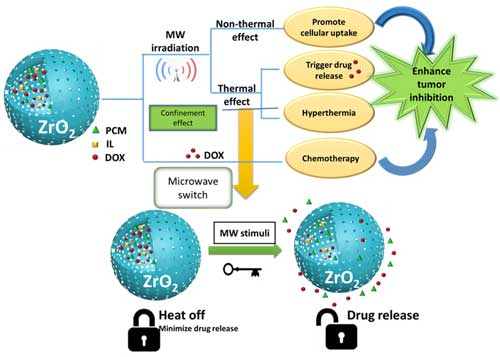| Posted: Oct 07, 2016 | |
Insights into the microwave non-thermal effect for tumor therapy |
|
| (Nanowerk Spotlight) Microwave hyperthermia is one of the most important clinical thermotherapy techniques due to the instinctive advantages of non-intrusive heating model, fair depth of penetration in tissues and ideal potential of killing tumor cells without surgical risks or toxicity of chemotherapy. | |
| Scientists at the Technical Institute of Physics and Chemistry, Chinese Academy of Sciences, have now developed a novel IL-DOX-PCM@ZrO2 multifunctional nanoplatform to combine the non-thermal and thermal effects of microwave to achieve enhanced thermal/chemo cancer therapy under mild microwave irradiation. | |
| They report their findings in the September 30, 2016 online edition of ACS Nano ("Multisynergistic Platform for Tumor Therapy by Mild Microwave Irradiation-Activated Chemotherapy and Enhanced Ablation"). | |
| Microwave therapy, as a promising type of tumor thermal therapy, has been attracting more and more attention recently. The thermal effects are the predominant biological response of microwave irradiation, whose wavelength lies between 1 m (300 MHz) and 1 mm (300 GHz). | |
| Due to the advantages over other ablation methods – such as broader heating zone, faster heat generation, less susceptibility to heat-sink effect – microwave ablation is prevalently used for clinical tumor treatment with favorable therapeutic efficacy in Far East countries. | |
| Discovered just one year ago, microwave susceptible agents are micro/nanomaterials with unusual microwave-thermal transformation efficiency (see previous Nanowerk Spotlight: "New 'smart' nanoparticle platform for cancer thermotherapy"). The enhanced microwave hyperthermia with improved survival and pain control is achieved by the agents through targeted and localized heating of tumor. | |
 |
|
| Schematic illustration of the thermal/chemo combined cancer therapy under mild microwave irradiation of IL-DOX-PCM@ZrO2 drug delivery nanoplatforms. microwave non-thermal effect could promote the cellular uptake of nanomaterials and anticancer drugs. Thermal effect, on the one hand, could cause the temperature of tumor site rise, on the other hand, trigger the drug release when the temperature was high enough. In the process of drug release, PCM was used as microwave switch. Hence, the as-made multifunctional nanoplatforms can realize combined therapy that promote cellular uptake under non-thermal microwave effect, and eliminate the tumor cells under thermal- and chemotherapy when irradiated by mild microwave. (Reprinted with permission by American Chemical Society) (click on image to enlarge) | |
| Compared to the thermal effects, there has been no report about the non-thermal effect of microwave in tumor therapy. In this present paper now is the first to report that the non-thermal effect of microwave could significantly promote the cellular uptake of nanoparticles and anticancer drug, which undoubtedly provides a new perspective for cancer therapy. | |
| "In order to enhance the effect of tumor inhibition, we developed multifunctional IL-DOX-PCM@ZrO2 nanoplatforms to combine the non-thermal and thermal effect of microwave with chemotherapy to enhance tumor inhibition," says Prof. Xianwei Meng, who led the research team. "When we applied mild microwave irradiation (0.9 W, 450 MHz) to the tumor site, the thermal effect of microwave caused the temperature of the tumor site to rise. On the other hand, it will trigger the microwave switch which was constructed by PCM to open and release DOX when the temperature was high enough." | |
| At the same time of drug release, the microwave non-thermal effect improves the cellular uptake of nanomaterials and anticancer drugs. | |
| This study first utilized the non-thermal effect of microwave to achieve enhanced thermal/chemo cancer therapy under mild microwave irradiation. | |
|
Provided by Prof. Xianwei Meng, Technical Institute of Physics and Chemistry, Chinese Academy of Sciences
|
|
|
Become a Spotlight guest author! Join our large and growing group of guest contributors. Have you just published a scientific paper or have other exciting developments to share with the nanotechnology community? Here is how to publish on nanowerk.com. |
|
